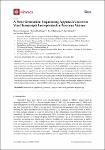A Next-Generation Sequencing Approach Uncovers Viral Transcripts Incorporated in Poxvirus Virions
Grossegesse, Marica
Döllinger, Jörg
Haldemann, Berit
Schaade, Lars
Nitsche, Andreas
Transcripts are known to be incorporated in particles of DNA viruses belonging to the families of Herpesviridae and Mimiviridae, but the presence of transcripts in other DNA viruses, such as poxviruses, has not been analyzed yet. Therefore, we first established a next-generation-sequencing (NGS)-based protocol, enabling the unbiased identification of transcripts in virus particles. Subsequently, we applied our protocol to analyze RNA in an emerging zoonotic member of the Poxviridae family, namely Cowpox virus. Our results revealed the incorporation of 19 viral transcripts, while host identifications were restricted to ribosomal and mitochondrial RNA. Most viral transcripts had an unknown and immunomodulatory function, suggesting that transcript incorporation may be beneficial for poxvirus immune evasion. Notably, the most abundant transcript originated from the D5L/I1R gene that encodes a viral inhibitor of the host cytoplasmic DNA sensing machinery.
Dateien zu dieser Publikation
Keine Lizenzangabe

